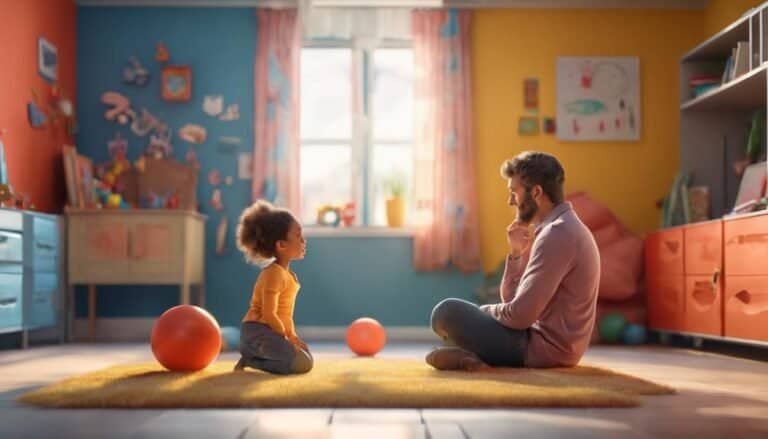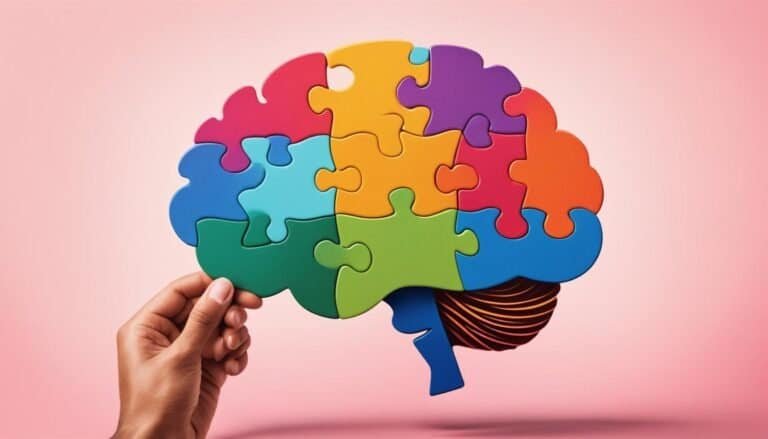Exploring Attachment Theory (Bowlby) Fundamentals
Ever thought about how our early emotional bonds shape our lives? Attachment Theory (Bowlby) shows us the deep impact of these connections. John Bowlby believed that our psychological connections start in infancy. They shape our child development in many ways.
This idea helps us see how our early experiences shape our emotional and social lives. It’s key to understanding how we connect with others.
Key Takeaways
- Attachment Theory, developed by John Bowlby, emphasizes the importance of early emotional bonds.
- Mary Ainsworth’s research identified three attachment styles, paving the way for a deeper understanding of child behavior.
- Attachment issues can stem from early experiences of neglect or trauma, leading to potential disorders.
- Secure attachment promotes positive outcomes like better self-esteem and social relationships.
- Understanding these patterns can help in various fields, from parenting to therapy.
Introduction to Attachment Theory
Attachment Theory (Bowlby) is key to understanding emotional relationships in our lives. It shows how we naturally need strong bonds, especially with caregivers as kids. These early connections shape our behavior and emotional health later.
Studies in 2016 and later linked attachment styles to mental health issues. They found that how we attach to others affects our mental health. This means early experiences with attachment set the stage for how we handle emotions and problems.
John Bowlby said that babies act out to keep and form bonds with caregivers. He pointed out that certain caregiver traits, like soothing and being a safe base, are crucial for healthy attachments. Knowing this helps us see how Attachment Theory impacts creating supportive environments for kids.
Attachment Theory is now used in many areas, like parenting and therapy. Recent studies show how important it is to build emotional connections early. They also show how attachment helps in treating emotional issues.
As we look for deep connections, Attachment Theory gives us deep insights into our relationships. By understanding these patterns, we can aim for better emotional bonds. This can improve our overall well-being.
John Bowlby: The Pioneer of Attachment Theory
John Bowlby, a British psychoanalyst born in 1907, changed how we see the emotional links between kids and their caregivers. He studied how these early ties affect our emotional connections later in life. His work started a new area in developmental psychology and showed how important it is for kids to feel secure with their caregivers.
The Background of John Bowlby
John Bowlby used theories like evolutionary biology and cognitive theory to create attachment theory. His time as a medic in World War II deeply influenced his views on human relationships and emotional health. He believed the first two and a half years of life are key for forming secure attachments. His work, including “Maternal Care and Mental Health,” stressed the need for close, loving relationships between babies and their caregivers.
Key Concepts Introduced by Bowlby
Bowlby’s theory changed psychology with new ideas. He said kids naturally want to be close to their main caregivers, like mothers. This idea of a single main bond was a big change. Bowlby showed how attachments grow in stages, from pre-attachment to forming deep connections. This has helped us understand human behavior and emotional needs better.
| Concept | Description |
|---|---|
| Monotropy | The idea that infants typically form a primary attachment to one caregiver. |
| Attachment Phases | Stages of attachment development: pre-attachment, attachment-in-the-making, clear-cut attachment, and reciprocal relationships. |
| Internal Working Model | A mental framework developed in childhood that shapes future relationships and behavior. |
| Caregiver Attachment | The relationship dynamics between the child and their primary caregiver, crucial for emotional stability. |
The Importance of Early Bonds
Early bonds are key to a child’s future. They shape emotional and social growth. These bonds with primary caregivers set the stage for trusting relationships later in life.
How Attachment Influences Child Development
Secure early bonds are crucial for healthy growth. Bowlby’s attachment theory shows how important it is to be there for your child early on. Kids form strong bonds with caregivers between 7 to 11 months old.
Children with secure attachments tend to be emotionally stable and do well in school. On the other hand, insecure attachments can lead to problems in forming relationships and may increase anxiety and depression later on.
Attachment as a Survival Mechanism
Attachment is a key survival tool for young children. Feeling secure helps them seek comfort when they’re upset, which is important for their safety. Without it, kids might avoid help and struggle to make important connections.
Bowlby believed this attachment is an evolutionary trait. It keeps children close to their caregivers, ensuring their safety and well-being.
| Attachment Style | Characteristics | Long-term Outcomes |
|---|---|---|
| Secure | Distress upon separation; reassurance upon reunion | Better self-esteem; lower rates of depression |
| Avoidant | Avoid seeking help; may stem from neglect | Difficulties in relationships; trouble trusting others |
| Ambivalent | Distress upon separation; inconsistent behavior | Difficulty forming stable relationships; higher anxiety |
| Disorganized | Confusion and resistance towards caregivers | Increased risk for emotional disorders; relationship difficulties |
Attachment Theory (Bowlby): Core Principles
John Bowlby’s attachment theory highlights the vital role of the attachment system. It makes babies seek comfort from their caregivers when scared or upset. This helps them feel safe. Bowlby believed that behaviors like crying and smiling are natural ways for babies to connect with their main caregivers.
The Attachment Behavioral System
The attachment system is key to building strong relationships. Bowlby said having a main attachment figure, often the mother, is crucial for a child’s well-being. This bond forms early, between 2.5 to 5 years old.
When kids feel insecure or are separated, they use behaviors to stay close to their caregivers. These actions help them survive. The way caregivers respond to these behaviors is what strengthens the bond, not just giving food.
The Role of Caregivers in Attachment
Caregivers play a huge role in a child’s emotional growth. They need to be there for the child during the first two years. If they’re not, it can lead to emotional and thinking problems later.
Bowlby found that being away from the main caregiver for a long time can cause emotional issues. This shows how important early relationships with caregivers are for a child’s future.
| Core Principle | Description |
|---|---|
| Monotropy | Infants form a primary attachment, often with their mother, which is crucial for survival. |
| Critical Period | A specific timeframe (2.5 to 5 years) when attachment behaviors are most effectively developed. |
| Attachment Behaviors | Actions such as crying and smiling that promote closeness to caregivers. |
| Caregiver Responsiveness | The quality of care impacts attachment security, more than the satisfaction of basic needs. |
| Maternal Deprivation Hypothesis | Disruption in attachment can lead to long-lasting emotional and cognitive difficulties. |
Understanding Attachment Patterns
Attachment patterns are key to emotional and social growth. John Bowlby’s work helped us understand these patterns. He showed the difference between secure and insecure attachments.
Secure Attachment Explained
Secure attachment comes from caregivers who are sensitive and responsive. This makes children feel safe and supported. They become confident in exploring their world.
Research shows that securely attached kids have better social and emotional skills. They stay close to their caregivers but also like to explore. This builds a strong emotional base. It helps them be resilient and have positive relationships.
Insecure Attachment Types
Insecure attachments happen when caregivers are not consistent or caring. Ainsworth found different insecure types, like avoidant and anxious-ambivalent. Avoidant kids don’t want comfort from caregivers and seem not to care when upset.
Anxious-ambivalent kids cling to their caregivers but don’t like comfort. This makes their emotional life hard. These patterns can affect how they handle emotions and build relationships, leading to problems as adults.
| Attachment Type | Characteristics | Impact on Relationships |
|---|---|---|
| Secure Attachment | Trusting, emotionally stable, comfortable with intimacy | Healthy relationships, no fear of abandonment |
| Avoidant Attachment | Indifferent, self-reliant, avoids closeness | Avoids intimacy, often feels uncomfortable in relationships |
| Anxious-Ambivalent Attachment | Clingy, dependent, often feels unloved | Struggles with expressing love, fears partners’ rejection |
| Disorganized Attachment | Inconsistent actions, can appear fearful or confused | Challenges in relationships, high risk of emotional difficulties |
Knowing about attachment patterns helps in parenting and therapy. It shows the importance of nurturing relationships. This is backed by the National Research Council and the Institute of Medicine.
The Impact of Secure Attachment on Development
Understanding secure attachment shows us how it affects human growth. Early relationships shape many parts of childhood and bring lasting benefits. They help build a strong base for emotional and social health.
Benefits in Childhood
Secure attachment is key in childhood, boosting emotional smarts and social skills. Kids with secure bonds show:
- Improved self-esteem – They feel more confident in what they can do.
- Stronger social skills – They easily make friends and build good relationships.
- Superior emotional regulation – They handle emotions better.
So, kids with secure attachments have fewer behavior problems. They have the emotional strength to bounce back, which is key for growing up well.
Long-term Outcomes in Adulthood
Secure attachments in early years also shape adult life. Adults with these early bonds often have:
- Healthier relationships – They pick positive friends and partners.
- Successful career pathways – Their social skills help in teamwork and leadership.
- Better mental health – They face less anxiety and depression.
Neuroscience shows that early support builds emotional strength. This helps people deal with stress better. Secure attachments lead to a better life overall.
| Developmental Stage | Benefits of Secure Attachment | Potential Risks of Insecure Attachment |
|---|---|---|
| Childhood | Improved self-esteem, stronger social skills, enhanced emotional regulation | Behavioral issues, lower emotional intelligence |
| Adulthood | Healthier relationships, career success, better mental health | Higher risks of relationship difficulties, mental health issues |
Investing in secure attachment early is crucial. It shapes not just short-term gains, but also long-term benefits that boost well-being throughout life.
Mary Ainsworth and Attachment Styles
Mary Ainsworth made big strides in attachment theory. Her work, especially the Strange Situation study, changed how we see early emotional bonds. She showed how these bonds form and are shaped by caregivers.
The Strange Situation Study
Ainsworth’s study watched 100 American families with kids aged 12 to 18 months. She put the kids in a new setting and watched how they reacted to being separated and reunited with their moms and a stranger. She found three main attachment styles:
- Secure Attachment: Kids feel a strong connection with their caregivers and trust them.
- Anxious Attachment: Kids get anxious about being close, due to unpredictable caregiver reactions.
- Avoidant Attachment: Kids don’t want to get close or rely on their caregivers much.
Different Attachment Styles Identified by Ainsworth
Ainsworth’s findings are key to understanding how attachment affects our emotional health and relationships. Each style comes from how caregivers act and respond:
| Attachment Style | Characteristics |
|---|---|
| Secure | Trusting, seeks and maintains proximity with caregiver, positive relationship view. |
| Anxious | Worried about availability, seeks closeness but fears abandonment, inconsistency in caregiving. |
| Avoidant | Indifferent to caregiver’s presence, prefers exploration over closeness, minimizes emotional expression. |
Mary Ainsworth’s work is still vital today. It helps us grasp attachment styles and their impact on kids and their emotional lives.
Attachment Theory Development Over Time
Attachment Theory has grown a lot, affecting many areas of psychology. It started with early ideas from psychoanalysis and behaviorism. Bowlby and Ainsworth built on these ideas, leading to more research and studies.
Influences from Other Psychological Theories
Attachment Theory was shaped by many other theories. Psychoanalysis helped us understand how early feelings affect us later. Behavioral theories showed how parents’ actions help shape kids’ feelings of safety.
This mix of ideas made researchers very curious. They looked into it a lot. A search in PsycInfo found over 15,000 articles on the topic, showing how much people care about it.
Subsequent Research and Findings
Later studies built on what Bowlby and Ainsworth found out. By the 2000s, groups like the National Research Council used Attachment Theory in child development policies. These studies showed a strong link between early attachments and how well kids do later on.
Since the 1980s, research has shown that attachment matters throughout life. It affects relationships from when we’re babies to when we’re grown. Mary Main’s work showed how attachment patterns can pass down through families.
About 60% of kids have secure attachments, while 20% have anxious or avoidant ones. Researchers like Hazan and Shaver found that these early patterns can show up in adult relationships too. This shows how important early attachments are.
Attachment Theory Applications in Real Life
Attachment theory helps us understand how early relationships shape our lives. It shows how caregivers can build strong bonds with children. This is key for kids’ emotional health.
Parents play a big role in this. Being responsive and sensitive is crucial. It helps shape a child’s attachment style and growth, especially for those at risk.
Implications for Parenting Practices
Attachment theory has changed parenting. Now, programs like video-feedback are used to help parents and kids connect better. These programs aim to help kids develop secure attachments.
About 60% of kids show secure attachment behaviors. This shows how important supportive parenting is. It also highlights the benefits of early help in child development.
Use in Therapy and Counseling
In therapy, attachment theory is key. It helps therapists work on attachment issues in their clients. It shows how early relationships shape our adult relationships.
Therapists use this knowledge to change unhealthy attachment patterns. This leads to better relationships and emotional control. It also boosts mental health and overall well-being.







